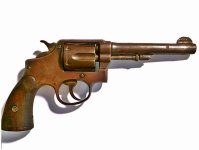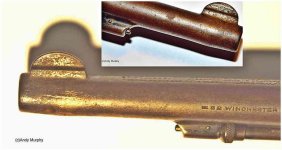At gun shop to get 32-20 Revolver cleaned, and was informed that small bulge beneath sight at end of barrel is a risk factor if gun is shot. Back home I carefully examine bulge and it appears to be a metal strip with the sight which was fused onto the end of the barrel during manufacture. Is this reasonable and consistent with 1905 construction practices?
You are using an out of date browser. It may not display this or other websites correctly.
You should upgrade or use an alternative browser.
You should upgrade or use an alternative browser.
Bulge at end of barrel beneath sight on 1905_Ejector
- Thread starter Peanuts
- Start date
Register to hide this ad
Welcome to the forum.
Front sight base and blade are forged in one piece with the barrel, not fused in place. If the gun was to be a target model, the factory milled off the blade, milled in a mortise, and a target blade was pinned into the mortise.
Gun shop personnel can be very knowledgeable but unfortunetly, can also be sources of much misinformation. If there is a bulge in the barrel, it is not an unsafe condition and usually has no or little effect on accuracy, unless it affects the muzzle.
Front sight base and blade are forged in one piece with the barrel, not fused in place. If the gun was to be a target model, the factory milled off the blade, milled in a mortise, and a target blade was pinned into the mortise.
Gun shop personnel can be very knowledgeable but unfortunetly, can also be sources of much misinformation. If there is a bulge in the barrel, it is not an unsafe condition and usually has no or little effect on accuracy, unless it affects the muzzle.
Welcome to the Forum.
The front sight was forged on the end of the barrel when it was built. It sounds like the barrel has been cut and the front sight reattached.
Can you post pictures, both of the sight and the inside of the bore?
The front sight was forged on the end of the barrel when it was built. It sounds like the barrel has been cut and the front sight reattached.
Can you post pictures, both of the sight and the inside of the bore?
Last edited:
Welcome to the Forum. Your picture shows what looks like a bulge on the bottom of the barrel under the sight. Take a straight edge and lay it alone the underside of the barrel and you should see it clearly. Pressures upon firing decrease dramatically as the bullet passes beyond the first couple of inches Of the barrel and by the time it gets to the muzzle, the pressures should be plenty low enough to so as not to cause any danger. The downside is that a bulge near the muzzle could ruin accuracy.
Thanks: Revolver has been in family back to my grand dad and, I recently got interested in taking care of it. Have been considering the option to install a new barrel but, so far, have not located a gunsmith to do the task. Emailed Darlington Gun about it, but, so far, no reply. I'm in Charleston, SC, and, most options here are Gander Mountain, Dick's and other retailers interested in selling new items to maximize profit.
I see no need to spend any money on it, its an heirloom, I would keep it the way it came to you. If you want to shoot it, that's good too. But unless it won't it the side of the barn, shoot it as is. If you want to shoot a lot, find a newer, used gun.
That looks like a bulge to me. Do you have a close up of the "strip of metal" area of the gun?
A bulge could have been caused by an obstruction near the end of the barrel, mud, snow or a cleaning patch. Usually happens with long guns when they get stuck in the mud or snow inadvertently plugging them. It did not blow up when the bulge was formed, it should be good now. I would not change the barrel. Appropriate shooting of a family heirloom is "light loads, once in a while." If the gun shoots well enough to hit a target that is good enough. It is not a deer rifle or a (modern) self defense gun. I could see rebarrelling a deer rifle if you wanted to shoot a deer with the same gun your grandfather used.
A bulge could have been caused by an obstruction near the end of the barrel, mud, snow or a cleaning patch. Usually happens with long guns when they get stuck in the mud or snow inadvertently plugging them. It did not blow up when the bulge was formed, it should be good now. I would not change the barrel. Appropriate shooting of a family heirloom is "light loads, once in a while." If the gun shoots well enough to hit a target that is good enough. It is not a deer rifle or a (modern) self defense gun. I could see rebarrelling a deer rifle if you wanted to shoot a deer with the same gun your grandfather used.
Last edited:
I have had several revolvers with bulged barrels that shot just fine.
"If" the accuracy is so bad you want to re-barrel consider having the original barrel lined. A good gunsmith can drill out the original and fix in a replacement liner is such a way it won't even be noticeable. You will have the advantage of a new barrel while keeping the appearance of your family keepsake. It's probably less expensive to do so.
Thanks for the advice. I like the idea of relining the barrel. This morning, I took pictures of both sides of the end of barrel sight to show what may be indications of added metal beneath the sight plus I pointed a laser pointer down the barrel to see if it reveals any abnormality in the bore. Pictures taken with Nikon D800 and Micro Nikkor 60 f2.8G on a tripod.
Attachments
Given the condition of the revolver, you will not hurt the value by relining as H Richard proposes and I like the idea that this family heirloom could be a shooter for generations to come. Besides, I can not even see any rifling in that barrel. Ballistics would suggest that when a bullet is upset by the air space at the bulge, it does not have enough barrel left to recover. I have shot guns with bulges mid-way down the barrel and they shot fine, but would suspect poor accuracy with the bulge near the muzzle and the apparent lack of rifling.
Relining can be done simply by boring out the barrel to 13mm and either soldering or gluing a 32-20 liner in place, then finishing the crown and forcing cone. Advantages are that this can be done without removing the barrel, it leaves the original serial number on the barrel flat, and will give you and future generations much more satisfaction at the range.
Just checked Track of the Wolf to find that they sell barrel liners by the inch ($5.89/inch)
http://www.trackofthewolf.com/List/Item.aspx/637/1
Relining can be done simply by boring out the barrel to 13mm and either soldering or gluing a 32-20 liner in place, then finishing the crown and forcing cone. Advantages are that this can be done without removing the barrel, it leaves the original serial number on the barrel flat, and will give you and future generations much more satisfaction at the range.
Just checked Track of the Wolf to find that they sell barrel liners by the inch ($5.89/inch)
http://www.trackofthewolf.com/List/Item.aspx/637/1
Last edited:
Another thing that can be done is a counter bore to the muzzle. Done just past the bulge damage, no bigger in dia than needed to clean up any rifling on either side of the bulge. Down in far enough to establish a new muzzle w/crown.
It takes a piloted bit to do a nice job but is far less of an operation than a liner. If there is a resemblance of rifling still in the bore, it might do the trick in restoring some accuracy if you find the bulge creating shotgun patterns.
Just a thought.
Personally,,I'd leave it just the way it is, just preserve it.
Shooting it a little won't hurt it as long as the mechanics are OK.
It doesn't have to prove anything at the range or on a target. Just the fact that you're handling & perhaps shooting the same revolver your Grandad owned is enough.
Stuff like that is priceless.
It takes a piloted bit to do a nice job but is far less of an operation than a liner. If there is a resemblance of rifling still in the bore, it might do the trick in restoring some accuracy if you find the bulge creating shotgun patterns.
Just a thought.
Personally,,I'd leave it just the way it is, just preserve it.
Shooting it a little won't hurt it as long as the mechanics are OK.
It doesn't have to prove anything at the range or on a target. Just the fact that you're handling & perhaps shooting the same revolver your Grandad owned is enough.
Stuff like that is priceless.
Thanks so much for detailing such good options on how to proceed with the 1905 Revolver. I want to be sure I'll be buying the right 32 caliber ammo Basically, is there a way I can be sure that it is 32-20, short of buying and trying 32-20? The barrel shows 32: Are there build characteristics which indicate 32-20? Thanks!
32-20 is a round developed by Winchester, it meant a .32 caliber bullet with 20 grains of powder. It was originally intended as a black powder cartridge. All of the normal factory made 32-20 rounds manufactured by the likes of Remington or Winchester were made to be safely operated in older firearms such as your Model of 1905. The round itself is either designated 32-20 WCF, or 32-20 Winchester. The other .32 caliber rounds are usually designated .32 Short, .32 Long, .32 S&W, etc. I have purchased 32-20 ammunition off the internet through any number of sources, as well as locally at pawn shops. The Remington stuff is the most often found and is loaded with a 100 grn. lead bullet. I now reload all the 32-20 I shoot in both my 1905 S&W and Winchester 1892.
You did state the gun is a 32-20? Most of these revolvers will be stamped 32 Winchester, 32 WCF, or 32-20. There were no other 32 caliber K frames available for this model in the early years of production. They were either 38 Special or 32-20.
looks like the barrel says 32 Winchester. That is a 32-20.
Thanks for the advice. I like the idea of relining the barrel. This morning, I took pictures of both sides of the end of barrel sight to show what may be indications of added metal beneath the sight plus I pointed a laser pointer down the barrel to see if it reveals any abnormality in the bore. Pictures taken with Nikon D800 and Micro Nikkor 60 f2.8G on a tripod.
The only thing I can see in the barrel looks like it's obstructed with lead from the last bullet fired. Make sure the barrel is clear before shooting it!
You may need a lead remover.
Similar threads
- Replies
- 19
- Views
- 563
- Replies
- 0
- Views
- 180
- Replies
- 67
- Views
- 3K
- Replies
- 48
- Views
- 4K



